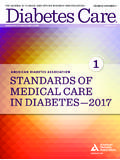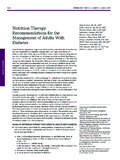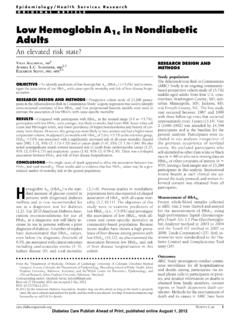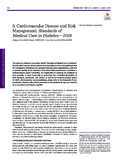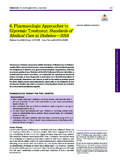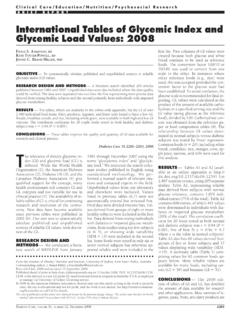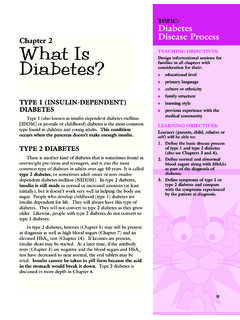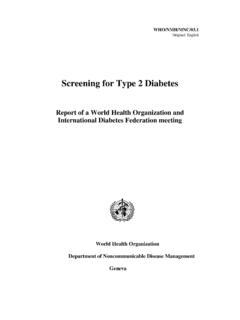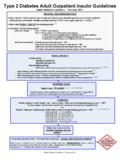Transcription of Diagnosis and Classification of American Diabetes ...
1 Diagnosis and Classification ofDiabetes MellitusDEFINITION AND DESCRIPTION OF Diabetes MELLITUSD iabetes is a group of metabolic diseases characterized by hyperglycemia resultingfrom defects in insulin secretion, insulin action, or both. The chronic hyperglycemiaof Diabetes is associated with long-term damage, dysfunction, and failure ofdifferent organs, especially the eyes, kidneys, nerves, heart, and blood pathogenic processes are involved in the development of Diabetes . Theserange from autoimmune destruction of the pancreaticb-cells with consequentinsulin deficiency to abnormalities that result in resistance to insulin action.
2 Thebasis of the abnormalities in carbohydrate, fat, and protein metabolism in diabetesis deficient action of insulin on target tissues. Deficient insulin action results frominadequate insulin secretion and/or diminished tissue responses to insulin at one ormore points in the complex pathways of hormone action. Impairment of insulin secretionand defects in insulin action frequently coexist in the same patient, and it is often unclearwhich abnormality, if either alone, is the primary cause of the of marked hyperglycemia include polyuria, polydipsia, weight loss,sometimes with polyphagia, and blurred vision.
3 Impairment of growth andsusceptibility to certain infections may also accompany chronic , life-threatening consequences of uncontrolled Diabetes are hyperglycemiawith ketoacidosis or the nonketotic hyperosmolar complications of Diabetes include retinopathy with potential loss ofvision; nephropathy leading to renal failure; peripheral neuropathy with risk of footulcers, amputations, and Charcot joints; and autonomic neuropathy causinggastrointestinal, genitourinary, and cardiovascular symptoms and sexualdysfunction.
4 Patients with Diabetes have an increased incidence of atheroscleroticcardiovascular, peripheral arterial, and cerebrovascular disease. Hypertension andabnormalities of lipoprotein metabolism are often found in people with vast majority of cases of Diabetes fall into two broad etiopathogeneticcategories (discussed in greater detail below). In one category, type 1 Diabetes , thecause is an absolute deficiency of insulin secretion. Individuals at increased risk ofdeveloping this type of Diabetes can often be identified by serological evidence of anautoimmune pathologic process occurring in the pancreatic islets and by geneticmarkers.
5 In the other, much more prevalent category, type 2 Diabetes , the cause is acombination of resistance to insulin action and an inadequate compensatory insulinsecretory response. In the latter category, a degree of hyperglycemia sufficient tocause pathologic and functional changes in various target tissues, but withoutclinical symptoms, may be present for a long period of time before Diabetes isdetected. During this asymptomatic period, it is possible to demonstrate anabnormality in carbohydrate metabolism by measurement of plasma glucose in thefasting state or after a challenge with an oral glucose load or by degree of hyperglycemia (if any) may change over time, depending on theextent of the underlying disease process (Fig.)
6 1). A disease process may be presentbut may not have progressed far enough to cause hyperglycemia. The same diseaseprocess can cause impaired fasting glucose (IFG) and/or impaired glucose tolerance(IGT) without fulfilling the criteria for the Diagnosis of Diabetes . In some individualswith Diabetes , adequate glycemic control can be achieved with weight reduction,exercise, and/or oral glucose-lowering agents. These individuals therefore do notrequire insulin. Other individuals who have some residual insulin secretion butrequire exogenous insulin for adequate glycemic control can survive without Fall : 2014 by the American Diabetes for Diabetes AssociationDiabetes CareVolume 37, Supplement 1, January 2014S81 POSITION STATEMENTI ndividuals with extensiveb-celldestruction and therefore no residualinsulin secretion require insulin forsurvival.
7 The severity of the metabolicabnormality can progress, regress, orstay the same. Thus, the degree ofhyperglycemia reflects the severity ofthe underlying metabolic process and itstreatment more than the nature of theprocess OF DIABETESMELLITUS AND OTHERCATEGORIES OF GLUCOSEREGULATIONA ssigning a type of Diabetes to anindividual often depends on thecircumstances present at the time ofdiagnosis, and many diabetic individualsdo not easilyfit into a single class. Forexample, a person diagnosed withgestational Diabetes mellitus (GDM)may continue to be hyperglycemic afterdelivery and may be determined tohave, in fact, type 2 , a person who acquiresdiabetes because of large doses ofexogenous steroids may becomenormoglycemic once theglucocorticoids are discontinued, butthen may develop Diabetes many yearslater after recurrent episodes ofpancreatitis.
8 Another example wouldbe a person treated with thiazides whodevelops Diabetes years later. Becausethiazides in themselves seldom causesevere hyperglycemia, such individualsprobably have type 2 Diabetes that isexacerbated by the drug. Thus, for theclinician and patient, it is less importantto label the particular type of diabetesthan it is to understand thepathogenesis of the hyperglycemia andto treat it 1 Diabetes (b-Cell Destruction,Usually Leading to Absolute InsulinDeficiency)Immune-Mediated DiabetesThis form of Diabetes , which accountsfor only 5 10% of those with Diabetes ,previously encompassed by the termsinsulin-dependent Diabetes or juvenile-onset Diabetes , results from a cellular-mediated autoimmune destruction oftheb-cells of the pancreas.
9 Markers ofthe immune destruction of theb-cellinclude islet cell autoantibodies,autoantibodies to insulin, autoantibodiesto GAD (GAD65), and autoantibodies tothetyrosinephosphatasesIA-2andIA-2b. One and usually more of theseautoantibodies are present in 85 90%ofindividuals when fastinghyperglycemiais initially detected. Also, the disease hasstrong HLA associations, with linkage tothe DQA and DQB genes, and it isinfluenced by the DRB genes. TheseHLA-DR/DQ alleles can be eitherpredisposing or this form of Diabetes , the rate ofb-cell destruction is quite variable,being rapid in some individuals (mainlyinfants and children) and slow in others(mainly adults).
10 Some patients,particularly children and adolescents,may present with ketoacidosis as thefirst manifestation of the have modest fastinghyperglycemia that can rapidly changeto severe hyperglycemia and/orketoacidosis in the presence of infectionor other stress. Still others, particularlyadults, may retain residualb-cellfunction sufficient to preventketoacidosis for many years; suchindividuals eventually becomedependent on insulin for survival andare at risk for ketoacidosis. At this latterstage of the disease, there is little or noinsulin secretion, as manifested by lowor undetectable levels of plasmaC-peptide.


